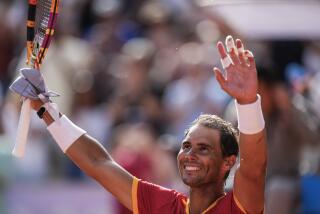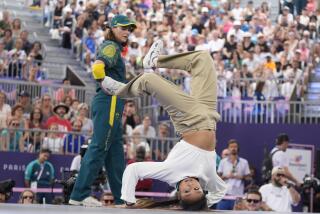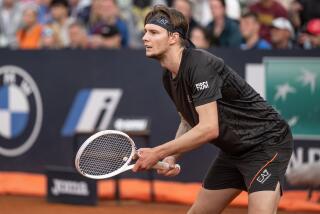Even When Losing, Rafter Shows Plenty of Promise
- Share via
The U.S. Davis Cup team was at its bickering, tenacious best last weekend against Australia in the semifinal at Washington. Pete Sampras, Michael Chang and Todd Martin prove that you don’t have to be a happy family to be a successful one.
Sampras was loose and ready but also cranky. His pitching in to play singles and the doubles match was typical. Martin’s coming back from stomach problems to play in the heat and humidity was admirable, as was Jim Courier’s stiff upper lip in accepting his role as bench-warmer, especially given his role in the first two rounds that got the U.S. team to the semifinals.
But the real hero was Chang, who had the toughest job of the weekend. He had to play firstFriday, against Patrick Rafter. Rafter broke Chang’s heart by winning the semifinal at the U.S. Open, denying Chang a chance at the title.
Facing the U.S. Open champion and the man who had provided him with his last two losses was not an easy task. Rafter was the hotter player and Chang had few weapons against Rafter’s serve-and-volley prowess.
But Chang is nothing if not resourceful. He outthought Rafter and played at the top of his game. His pride--often discounted because of Chang’s modesty--kicked him onto a level that gave the U.S. team the all-important first point.
There was more to the competition than that. In Davis Cup play, wisdom and experience often win out over youthful talent. On and off the court. The American team managed a clever con job on Rafter.
Sampras, in particular, was masterful in deflecting attention from himself and putting pressure on Rafter. “He won the U.S. Open, he’s a marked man,” Sampras said again and again during the week. “He’ll be expected to win all the time now.”
Even Chang chimed in, saying, “His life is going to change, it’s not going to be like before.”
The pressure put on the easygoing Rafter no doubt took its toll. When it was over, Sampras was asked if his quasi-praise of Rafter and attention to his new status was in fact part of an elaborate head game. Sampras raised his formidable eyebrows and fixed the questioner with a hard look.
“Strategy? Tactics?” Sampras said. Then he laughed hard.
Rafter was a prime target for such mind games. He’s young, he’s earnest and it’s all very new. Rafter took a week off after the Open in which he did nothing but party.
“He did all the things he hadn’t been doing for about three weeks before that,” Australian captain John Newcombe said. “You know what that does to you.”
It’s difficult to project where Rafter may go in the future. But one aspect of his game bodes well for him: Rafter has humility, and that acknowledgment of what he still has to learn will be a valuable tool.
After being steamrollered by Sampras, Rafter didn’t pretend the loss was anything other than the shellacking that it was.
“Brings you back down a little bit,” Rafter said, with his trademark wink. “It’s good, though. Good to be knocked around a little bit. I’ve got a lot to learn, a lot to do before I can concern myself with where I am right now. It makes me want to work harder, that’s all it does.”
AUSSIE ADVANTAGE: TRADITION
Sporting traditions are taken seriously in Australia. Newcombe spoke at length about the importance of mentoring and how it has shaped generations of Australian tennis players. It’s something he and co-captain Tony Roche are keen to reestablish.
“When Rochey and I played Davis Cup . . .we were traveling with the likes of Neale Fraser, Roy Emerson and Rod Laver,” Newcombe said. “They were already champions.
“We just followed what they did, their work ethic, and how they prepared for matches. By hanging around with them, you hang around with champions, you start to think like a champion.
“The guys following behind Tony and myself, they had to do it all by themselves. They never had that. Everything that had been before, everything that had been passed down from [Lew] Hoad, [Ken] Rosewall, Fraser, Emerson, Laver, how to think and act like a champion, it was lost.”
CHANGE IS GOOD
Suggestions abound as to ways to make the Davis Cup more accessible to players and fans. The most common is to change the format to an every-other-year competition. This would give players a break and might keep them from looking upon Davis Cup as drudgery. And fans presumably would be more excited about an event that is perceived as special.
Any number of other, sensible ideas are out there, but the International Tennis Federation shows little interest. Two reasons: The Davis Cup is healthy worldwide; it’s only in the United States that complaining exists. Second, the Davis Cup is a moneymaker, and as such it’s unlikely to be touched.
If the general format can’t be changed, U.S. captain Tom Gullikson likes the idea of a challenge-round system, in which the defending champion automatically makes the final and the rest of the world competes for the other spot.
“I’m sure that would get a great roar of approval from our players,” he said. “It would also be a great incentive for any team from any country, to win it and know they could defend it just by beating one team the following year. I think it’s got some merit.”
FED UP CUP
Where’s the interest in the women’s version of the Davis Cup? The Fed Cup flourishes despite its stepsister status. Its final is Oct. 4-5 in The Netherlands. The host team will take on France, coached by Yannick Noah, who also captains the French Davis Cup team.
The Dutch defeated the United States, the defending champion, and the Czech Republic. The French will be led by Australian Open champion Mary Pierce. Should France win, it will be the first time a captain has directed a team to Fed Cup and Davis Cup titles.
Noah, a great motivator, will probably do it. He guided the French Davis Cup team to the title last year through the sheer force of his will. He’s adept at making what some players view as an obligation into a fun and much-anticipated event.
He has his men’s team up in the morning doing yoga and meditating and he even has the often-dour Pierce enthused.
“He’s great to be around, we all just love it,” Pierce said.
His secret? Noah understands that playing tennis is fun and he communicates that to others.
What a concept.
(BEGIN TEXT OF INFOBOX / INFOGRAPHIC)
Career Prize Money
1. Pete Sampras: $29,467,000
2. Boris Becker: 24,016,323
3. Ivan Lendl: 21,262,417
4. Stefan Edberg: 20,630,941
5. Goran Ivanisevic: 15,597,077
6. Michael Chang: 15,072,629
7. Jim Courier: 13,183,402
8. Andre Agassi: 13,130,074
9. Michael Stich: 12,628,890
10. John McEnroe: 12,539,622
Note: With Sunday’s victory in the Grand Slam Cup, Sampras has collected $7,393,000 for posting a 16-3 record at that tournament over the years. That’s more than 25% of his career earnings.
More to Read
Go beyond the scoreboard
Get the latest on L.A.'s teams in the daily Sports Report newsletter.
You may occasionally receive promotional content from the Los Angeles Times.











